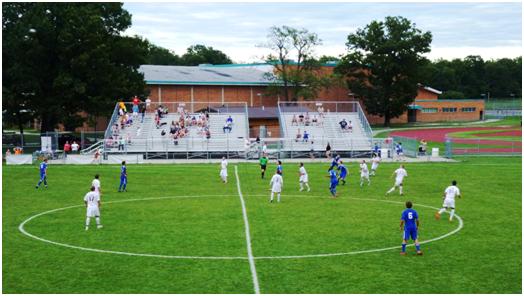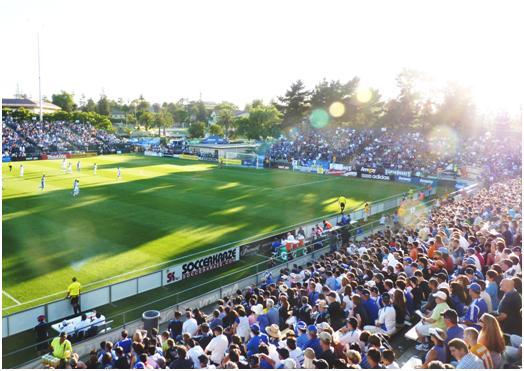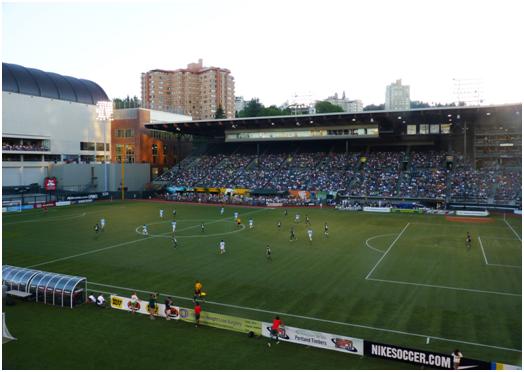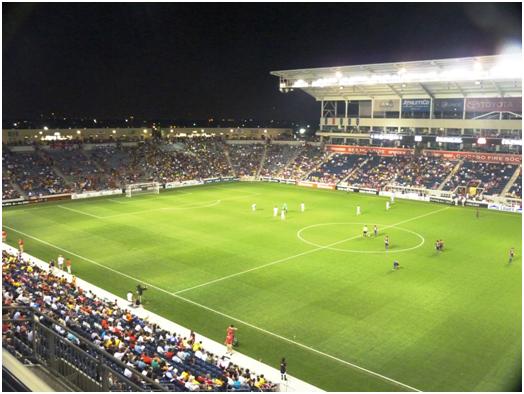USA: The Search for a Second Division.
Last summer, I returned to the USA, for my first visit in 11 years. It was a good trip with a dozen games watched over a two week period and although I focussed mainly on MLs games with the USA itself, I visited both Canada and Puerto Rico for the first time, with matches seen in the US Open Cup, the SuperLiga, the USSF division two and even the Premier Development League. By good fortune, I even managed a fixture in the Canadian Soccer League.

Kalamazoo Outrage Playing in the PDL Part of the USA Step 4
This was enough to give me some insight into the structure of football in the USA. Although there is no promotion and relegation between leagues in the USA, their Football Association, the USSF defines which of the various leagues is at each of the steps 1-4. Below this, all football is amateur and organised at state level under the auspices of the US Adult Soccer Association.
The unquestioned Step 1 League in the USA is Major League Soccer (MLS). This was founded in 1996 and after a difficult time in its early years, it now seems to be an established part of the American Sporting scene. The crowd figures, at around 16,000 per game in 2010 are in line with many other major leagues across the world. The MLS is not like most other football leagues, in so far as the league is the major entity involved, while the clubs are franchised granted by the leagues. Unlike any of the European Leagues, players’ contracts are with the league, not with the clubs and majority of the players are paid at levels fixed by the league. There are a small number of marquee players, whose salaries are above the general limits for the league, and whose pay must be generated by the clubs own profits.
With two new teams for 2011, the MLS will now have a 34 match regular season. Although its clubs will play the same 34 game home and away round robin system used in most leagues of similar size, its teams are also divided into two Conferences on a regional basis. Ten teams will then play in a knock out end of season competition for the overall title.
The system leads to some confusion. In 2010, eight teams (exactly half the league’s compliment) entered the play offs. The top two from each conference are guaranteed a place in the play offs, while the other four places come from the “combined table”. In 2010, the consequence of this was that only two eastern teams made it to the play offs, while six of the eight westerners qualified. This was the same breakdown as selecting the top eight from the combined table, but the fifth and sixth placed teams from the West were then re-categorised as third and fourth of the east for draw convenience. This led to the “Eastern Conference Final” being played between San Jose Earthquakes and Colorado Rapids, both of which play in the Western Conference. The overall champions ended up as Colorado, who had finished 7th in the original combined table, LA Galaxy having finished three points clear at the top, (and Western Conference Champions), lost the Western Conference title game to FC Dallas.
The final, played towards the end of November was staged at the BMO Field in Toronto.

San Jose take on DC United at the Buck Shaw Stadium. Despite playing in the Western Conference, the Earthquakes ended up playing in the Eastern Conference final
Until 2009, the second, third and some of the fourth level of USA football came under the auspices of the United Soccer Leagues, but for 2010 some of the teams tried to break away and form a new second level league of their own. This new league has been named the North American Soccer League, (NASL), deliberately chosen to evoke memories of the original NASL, which run for sixteen years from 1968, and known mainly for picking up world class star names, just prior to the retirement. Faced with two leagues, both having six clubs affiliated vying for sanction at the same level, the USSF decided not to leave the question open for one season, and instead run their own USSF Division Two including all of the 12 teams concerned. The two rival organisations were recognised in the division of the league into USL and NASL Conference. The match schedule did not reflect this though every team played a 30 match regular season, 22 of which were made the standard double round robin, while the extra eight were on a regional, but not Conference basis.
The top eight (from a combined table) entered the end of season play offs, these were five from the USL Conference, and three from the NASL. The combined table, rather than Conference tables were used for seeding the draws, and all play offs were over two legs (with the exception that the top two seeds had to be Conference Champions and hence these two could not meet until the final). Two teams of the USA level 2 league were Canadian, while one was from was from Puerto Rico. It was in fact the Puerto Rico Islanders, who had the lowest ranking of the eight teams in the play offs, that played Carolina Railhawks in the final. Railhawks would have been fourth in an overall combined table, but were second seeds as winners of the NASL Conference. Islanders finished 5th in the USL Conference.

A sparse crowd (1089) watches Carolina Railhawks win 2-0 at Puerto Rico Islanders in the regular season. For the same match-up in the League final, the crowd was better (6257). The Islanders won that match 2-0, and took the title with a 1-1 draw the following week.
The average attendance for the USSF Division 2 was 4449 in 2010, this is broadly comparable to the 4700 average for the previous season when the second level was an 11 club tourney entirely under the USL banner.
My 2010 trip did not allow me to see any game at the third level. This was administered by the USL and was called USL, Division 2. (In 2009, the second level was known as USL Division 1). There were only six teams in the 2010 league, and they played a 20 game season, with the top three going into a simple play off (one semi-final, one final, home advantage to higher placed team). Charleston Battery were top of the regular season table, and also won the play off final.
All of these three leagues levels appear to be full time professional, but as far as I can see none of the lower leagues are. There are two separate leagues which operate as Step 4. Both are played in regional conferences and divisions in different parts of the country, with no interaction between these until reach the play off stage.
The USL operates the Premier Development League, with 61 teams in 8 divisions (for 2010) despite varying numbers (between 6 and 10) in the divisions, they all play 16 games in the regular season, with one exception where and 8 team division played 14 games. The top two teams from each division then enters the play offs.
Meanwhile the National Premier Soccer League had 31 teams in 5 divisions. This only played around 8-10 games for each team, with play offs at the end.
The PDL demands that most of the players are under-23. A team is allowed to name a roster of 26 players of which only 8 can be over 23, but of the four teams I saw in action, the actual numbers of older players were only around the two or three mark. Each team must also have at least three under 18’s in their roster. A large number of the clubs pick their players mainly from College Football, (the PDL season is in the main within the college summer break). A few teams have become partially professional, but because of the amateur rules of the NCAA, (the main body for college sports), those that employ professionals cannot also use college players from the “elite colleges”. They can use players from colleges that are not part of the NCAA *
Reading the NPSL’s information on-line, there does not seem to be the age limits of the PDL, but the league also operates on an amateur basis, which means that it too can utilise college players.
While the NPSL is limited to USA teams, the PDL includes several Canadian outfits, and also Bermuda Hogges.
Both the level four leagues are continuing in similar formats for 2011, although both have an increased number of franchises, and each has added a division this season.
The MLS has also continued to expand, for 2011 it will have 18 teams still divided into two conferences, and still playing a double round robin (so 34 matches per team). A 19th team has already been confirmed for 2012, with the probability that this will soon increase to 20.

AT the Saputo Stadium, Montreal Impact (the MLS expansion team for 2012) take on Vancouver Whitecaps (MLS 2011 expansion)
While the upper and lower reaches of the American Soccer system have not changed, except in their number of teams, the middle ranks are still full of confusion. The USSF has defined the criteria which a second division needs to adhere to. These include a minimum eight teams, spread out across different time zones, with minimum financial criteria, ownership rules and the demand that 75% of teams play in metropolitan markets with a population of at least 750,000. That final rule is enough to mean that the English Premier League (and probably every other league in Europe) is unsuitable to be a second level league in USA.
Not surprisingly the rules have come in for a level of criticism. After all, with the rules only demanding that stadiums can hold 5000, and with average crowds around 4500 last season one would have expected that the importance is to bring in clubs that can regularly deliver this sort of average, and have facilities to suit. One city that does not have the size of population of Chattanooga, Tennessee. But it has the football club with the best average attendance in the NPSL at 4400, and the league’s highest ever (5117 when they played Rocket City United). My two viewings of football at this sort of level each had crowds of under 100. Surely the first thing the USSF should do is to sent someone down to Chattanooga to find out what is being done right, and then insist more clubs follow suit!
The USL have decided to combine their two professional divisions under the title USL-Pro. They have not applied for recognition as a level 2 league, and hence by default they are now level 3. Despite this, their officials will still believe this is the second highest league in the League, below the MLS. Actually, only one member of last season’s USSF Division 2 has joined the USL-Pro. Five of the old USL, Division 2 teams have stayed. There are nine new franchises, five of these are spread across the continent, in Orlando, New York, Dayton, Wilmington and LA, but the other four are not in the USA, but the Caribbean.
Three of these are from Puerto Rico, and played in last season in the Puerto Rico championships. Considering that a single PR club in the USSF division 2 last season failed to bring in the crowds, it is a surprise to find that there will now be four clubs from the Island playing in mainland competition.
The final member of the overseas new boys is the newly formed Antigua Barracuda. This will be the first professional football club on an island better known for cricket. The stadium used by Barracuda is known as the “Sir Vivian Richards Stadium”, and is of course sized for cricket!
The USL-Pro is divided into three conferences of five teams each. It is fair to say that it does not really have a National reach, so it has called its conferences, American (two teams in North Carolina, one in South Carolina, and one each in Florida and Virginia), National (two teams each from New York state and Pennsylvania, one from Ohio) and International (the three from Puerto Rico, Antigua and LA Blues). It is not difficult to spot that LA is the furthest of the teams from the Caribbean.
All teams will play 24 games, with the American and National conferences playing all teams in both conferences home and away, and six additional games. The International Conference teams play a double home and away round robin (16 games) with eight games (four home, four away against teams from the other conferences).

Portland Timbers take on Miami at PGE Park. The park is being updated for the MLS, and the local baseball team has been kicked off the ground
From last season’s USSF Division 2, only Rochester Rhinos has joined USL Pro. Portland Timbers and Vancouver Whitecaps move on up to the MLS, while four franchises (Austin Aztecs, St. Louis, Minnesota Thunder and Crystal Palace Baltimore) have closed down. The other five, including Puerto Rico Islanders, and Montreal Impact have joined the NASL. The new franchises are Atlanta Silverbacks, NSC Minnesota Stars and FC Edmonton. This is hardly national coverage. Minnesota and Edmonton find themselves a long way from the other sides in the league, while there is no one at all on the West Coast. Although Montreal Impact will leave at the end of the season to join the MLS, San Antonio Scorpions (from Texas) are confirmed as a new franchise for 2012, and it is expected that a renamed Baltimore team (no longer connected to Crystal Palace) will join.
The USSF provisional gave the new league its “Division 2 Sanction” last November, but they have since rescinded this, and more discussions are being held to decide whether the NASL will be at tier 2 or tier 3. If they do not get tier 2 sanction, then there will be no league at this level in the USA. In the meantime, the NASL has announced a programme giving each team 28 games (eight teams, playing home and away twice against every other team). Six out of the eight will play in the end of season play offs.

Chicago Fire take on the Mexican team, Monaracas Morelia in the SuperLiga
While the NASL and USL argue over who should run the second level of football in the USA, the most sensible answer to the question remains above this all. The answer in my mind is of course the MLS. If the MLS expands to 20 teams, then this will be the most that seriously be accommodated with each team playing all the others home and away but it is unlikely to lead to the end of their expansionist policies. Most of the teams concerned spend a period in the lower divisions before progressing to the MLS. This helps prospective entrants to get their houses in order and to prove they can draw sufficient crowds to justify the step up.
So why should not the MLS create its own second division? Why shouldn’t the USA join in with most of the rest of the World and have at least a partial meritocracy in its football? Would Promotion and Relegation bring the walls crumbling down, or would it create a new interest in the game below the MLS?
The biggest problem would be on the financial side. The franchises have existing contracts with the NASL and USL, and as these organisations exist to make a profit not merely for the good of the game. In the short term some accommodation would have to be arrived at before a two division MLS could be considered.
In addition, the USSF document says that clubs in a division two league need to be able to put up a bond of US$750,000 to join the league. When switching to the MLS First division they have to be able to increase this funding significantly. Other considerations, such as facilities may need to be updated to allow a club to progress. In most European countries, a club has to pass licensing criteria in order to progress up the leagues, or if they wish to enter European competition. As an MLS second division would include teams that may not yet be up to playing at the top level, it too would need the equivalent of licensing to structure the promotion process.
In England, relegation is such a serious blow to a club that a “parachute” payment has to be made to clubs going down. This is due to the sudden loss of income from TV and sponsorship contracts that occurs when a club loses its position, while players’ contracts are not tied to the division, and still have to be paid after relegation. Strangely enough, this would be less of a problem in the MLS, as the majority of players’ contracts are held not by the clubs, but centrally by the league.
FIFA statute (number 19, paragraph 1) demands that the composition of leagues should primarily be on the basis of merit. The rule was brought in after several cases around Europe where clubs were effectively “franchised” and moved from one city to another. In particular, the extremely high profile transfer of the 1988 English cup winners Wimbledon to Milton Keynes created a high degree of publicity. At the time of introduction, FIFA promised that the rule would not be used against those countries which used franchising instead of promotion and relegation, and they have not even taken action against recent breaches of this rule, such as in Belgium, and Thailand.
Still, when the vote came from the 2022 World Cup venue, countries using the franchise system (USA and Australia) were overlooked in favour of technically inferior bid. The reasons behind the FIFA decision will be complex, but with Blatter have criticised the USA’s system in public, this cannot have helped. At the least, should a two division structure be on the table, it will not harm a USA bid for the 2026 World Cup
There are enough professional football teams in USA and Canada for a two division structure to make sense. Promotion and relegation will create a new degree of excitement. A reason to get behind struggling clubs as the season comes to a close, and hopes of a play-off position are long gone. A single body to govern and run both divisions would surely be the best way to ensure the stability of this structure.
* I have since been informed that I may not be correct in this assumption, and that NCAA players – so long as they are not paid themselves – can line up in semi-professional teams